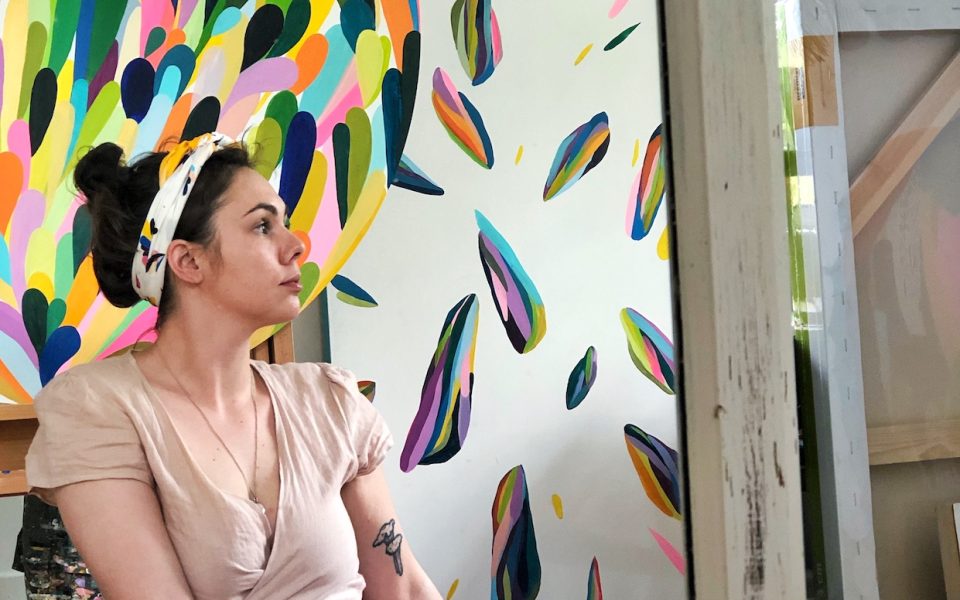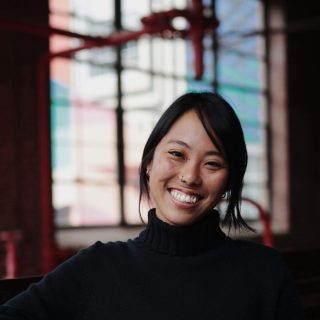You’ve probably seen her work before.
Broad, colorful brushstrokes that branch out from a central point and create a sprouting form of rapturous color. Bright pinks and teal greens interact and weave in and out from one another in tear-shaped droplets that form clouds or tornadoes or, on rare occasions, the artist herself.
Greensboro artist Angela Barker, known by her artist name as Angie the Rose, has been creating art since she was a child in the mountainous landscape of western North Carolina.
“Ever since I was a little girl, those were the most vivid memories I have from my childhood,” Barker says. “I was either playing in a mountain forest or making art. I was really obsessed with horses and I drew what I saw or painted what I saw back then.”
Since then, Barker has moved past representational art to the forays of abstract visualizations. Her pieces evoke images of the natural world like plants or horizons, but Barker explains that much of her work, particularly the Molecular Series for which she’s known, draws inspiration from the small molecules that make up our bodies. In July, she debuted her first solo exhibit named after the series at the Revolution Mill’s Central Gallery, and many of her pieces can be seen at area shops like Vivid Interiors, Tiny Greenhouse and Lao.

Barker says she started the Molecular Series, which is characterized by a cacophony of primary and secondary colors that branch across canvases, about six years ago during a difficult time in her life. The artist, who is now 32 years old, was going through a kind of quarter-life crisis and had just finished what she calls her Dark and Moody series, the first cohesive collection of art she made as an artist.

“It was kind of depressing,” she says about Dark and Moody. “I didn’t know what I was doing with my life but once I was done with the series and I had gotten all of this funk out of me, I realized that it was time to work with colors again. It was about embracing a healing process of sorts.”
At the onset of the series, the shapes Barker created tended to be more insular and closed off. More recently, she has been paying a woodworker to create cut-out wooden shapes to make the pieces more three-dimensional and open.
“In the beginning they were closed like a bud,” she says. “I was going through a hard time in my life, and the more I started healing, the more [the shapes] started opening up.”
Barker’s intent was to emphasize the importance of human bodies and what goes on beneath the surface. Part of that was finding a way to empower women through her art and depicting that gender or sex doesn’t limit any person’s capabilities in life.
“There should be no limitations because we have a vagina,” she says. “You can be a woman and choose to love bright and cheery colors and choose to have depth behind that.”
As visitors go to see the works at her new exhibit in person, Barker encourages them to listen to music. She says she likes to listen to lo-fi beats and German composer Nils Frahm as she paints, and offers them as suggestions.
-

Angie’s exhibit in the Central Gallery at Revolution Mill (courtesy photo) -

Angie’s exhibit in the Central Gallery at Revolution Mill (courtesy photo)
As the soft beats play through my headphones, the humming of the AC unit at the century-old mill fades away and the vibrancy of Barker’s pieces begin to pop against the beige walls of the gallery. In Barker’s Flora pieces, bursting tendrils reach out from a center point as they bend and arch and drip towards the floor. In Changes, the artist’s kaleidoscopic colors remain encapsulated in a white circle, resembling a vibrant snow globe. The hypnagogic lo-fi pop imbues a kind of psychedelic element to the pieces while the minor piano notes in Frahm’s compositions lend themselves to a more melancholic, introspective experience. Like a soundtrack in a movie, the music brings the art to life, allowing visitors to imagine the trajectory of Barker’s pigments past the limitations of their canvas. And that’s really the artist’s goal.
“I’m trying to make these creatures, these molecular beings more tangible in the world,” she says. “On a canvas their trapped but when they’re cut out, they could reach out and grab you.”
And even though she’s disappointed that her first solo show happened during a pandemic, Barker says COVID has given her more time to paint outside of her day job as a front-end web developer.
“It’s freed up my time so much more,” she says. “I don’t have to worry about commuting…. As soon as I’m done with my workday, I can shut my laptop and fully immerse myself in painting.”
And like before, when she faced personal struggles in her twenties, painting continues to be a way for Barker to stay in tune with her emotions, to find balance. She says she picks the colors she uses depending on her mood or the season, and the kinds of shapes she paints are determined by what’s going on in her life, too. While she normally doesn’t do many portraits, Barker says she’s been painting herself recently as a way to re-examine who she is as a person.
-

A self portrait by the artist. (courtesy photo) -

Barker painting in her home studio. (courtesy photo)
“My parents are going through a divorce,” she says. “I wanted to slice out the part of myself that my dad contributed to. Like, How can I be myself with him still in me? and How can I change or how can I learn to accept who I am?”
Barker says she eventually wants to be able to work full time as an artist and says she’ll continue evolving her Molecular Series, maybe even venturing out to do installation type pieces.
“I’m just trying to be a happy little artist with my rainbow palette,” she says. “It’s who I am. If I’m not creating some sort of abstract reality or playing with colors, I don’t know who I am.”
Learn more about Angie at @angietherose on Instagram, on Facebook and on her website at angietherose.com.
Join the First Amendment Society, a membership that goes directly to funding TCB‘s newsroom.
We believe that reporting can save the world.
The TCB First Amendment Society recognizes the vital role of a free, unfettered press with a bundling of local experiences designed to build community, and unique engagements with our newsroom that will help you understand, and shape, local journalism’s critical role in uplifting the people in our cities.
All revenue goes directly into the newsroom as reporters’ salaries and freelance commissions.


Leave a Reply